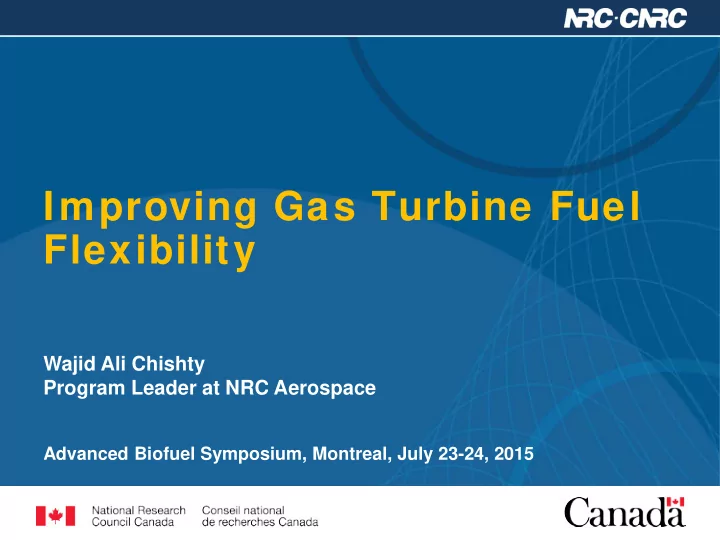

Improving Gas Turbine Fuel Flexibility Wajid Ali Chishty Program Leader at NRC Aerospace Advanced Biofuel Symposium, Montreal, July 23-24, 2015
Fuel Flexibility Spread High reactivity fuels Increasing C 2 + Challenge: Inquiries “Flashback” Natural Gas Syngas Increasing H 2 Traditional Variation 0 11.5 23.0 34.5 46.0 57.5 65.0 LHV (MJ/kg) (Ref: Wisniewski & Handelsman 2010) Low reactivity fuels Challenge: Blowout 2
Stable Gas Turbine Operational Regime High reactivity fuels Region of Equivalence ratio stable Low reactivity fuels operation Stoichiometric Flashback Blowout Mass flow rate Flashback limit Blowout limit 3
Plasma Assisted Combustion (PAC) • Types of plasma discharges Thermal Plasma Zone of plasma Corona formation aka equilibrium plasma Discharge spark, arc Non-thermal Plasma aka non-equilibrium, “silent” plasma V DC V DC DC – Corona discharge, Streamer Cathode Anode AC - Dielectric Barrier Discharge (DBD) Zone of plasma • Advantages formation DBD Virtually non-intrusive when not in use Solid-state - no moving parts Simple design All electrical - fast response Robust Electrodes Dielectric material 4
PAC - Methodologies • Chemical kinetic NRC effort to improve Ignition via thermal plasma flashback limit Initiation of chain branching reactions through electron excitation via non-thermal Equivalence ratio Region of plasma stable operation Flashback • Hydrodynamic Stoichiometric Ionic wind/ ionic propulsion Other efforts to (NRC experience) improve blowout limit Blowout Mass flow rate 5
Flame Flashback Mechanisms • Four types of flashback are recognized: Boundary layer Core flow Combustion instabilities Combustion Induced Vortex Breakdown (CIVB) • Occurs if the local flow velocity is lower than the flame speed: u Local < S u • Criteria for flashback in the boundary layer : S ∂ u f y = δ = ≤ ∂ g b δ F y b wall (Eichler & Sattelmayer, 2011) 6
Flashback Sensitivity to Velocity Profile Flashback through the core flow Boundary layer flashback (Schäfer et al., 2003) 7
NRC Experience – Dielectric Barrier Discharge (DBD) Combustion chamber Plasma region (volume) Ionic wind Premixer Dielectric barrier Insulation Electrodes 8
Control of Core Flow Flashback • No DBD actuation (b) (c) (a) Reducing air flow rate leading to flame flashback (a): Stable → (b): Start flashback → (c): Flashback • Application of DBD actuation Φ = 0.893 Φ = 0.843 Φ = 913 Φ = 0.773 9
Improvement in Stability Margin • For fixed flow rates of combustible mixture, the burner can be operated with fuels and/or blends of much higher flame speeds • For constant flame speeds, the combustor can be operated at much lower flow rates 10
Control of Boundary Layer Flashback ~200 s -1 ~400 s -1 1.2 1 0.8 u (m/s) 0.6 0.4 0.2 0 -28 -24 -20 -16 -12 -8 -4 0 4 8 12 16 20 24 28 Radial location (mm) u without DBD u with DBD Flame front 11
Improvement in Stability Margin • DBD actuation delays flashback to higher equivalence ratios • For given total flow rates, the DBD actuation allows to operate with mixtures of much higher flame speed 12
Conclusions • The proposed application of DBD: Increases the velocity gradient at the wall of the premixer Delays flashback to occurs at higher equivalence ratios and lower flow rates The stable operation regime is extended Allows the operation with mixtures of higher flame speed The combustion chamber is more fuel-flexible 13
National Research Council Canada Supporting Gas Turbine Innovation in Canada Wajid Ali Chishty Program Leader at NRC Aerospace Advanced Biofuel Symposium, Montreal, July 23-24, 2015
This document contains information that is confidential, proprietary or secret and should be treated as confidential by all recipients. If there is a confidentiality or non-disclosure agreement or protective order covering any information contained in this e-mail, such information shall be treated as confidential and subject to restriction on disclosure and use in accordance with such agreement or order, and this notice shall constitute identification, labeling or marking of such information as confidential, proprietary or secret in accordance with such agreement or order.
National Research Council Canada IRAP Research • Budget: ~$900M facilities • Over 3,700 employees and 575 volunteer and independent visitors 17
Mandate Help industry succeed and meet current and future societal needs Help industry succeed through de-risking the development and deployment of technologies and innovative solutions 18
More than $500M Investment in Facilities to Support Aerospace/Gas Turbine Innovation Full-Scale Structural Test Frames Wind Tunnels Research Aircrafts Engine & Combustion Test Cells 19
More than 350 Technical Experts in Aerospace/Gas Turbine Disciplines Materials & Coatings Manufacturing Combustion & Sprays Turbomachinery & Tribology & Mechanical Power & Propulsion Aerodynamics Components 20
Recommend
More recommend